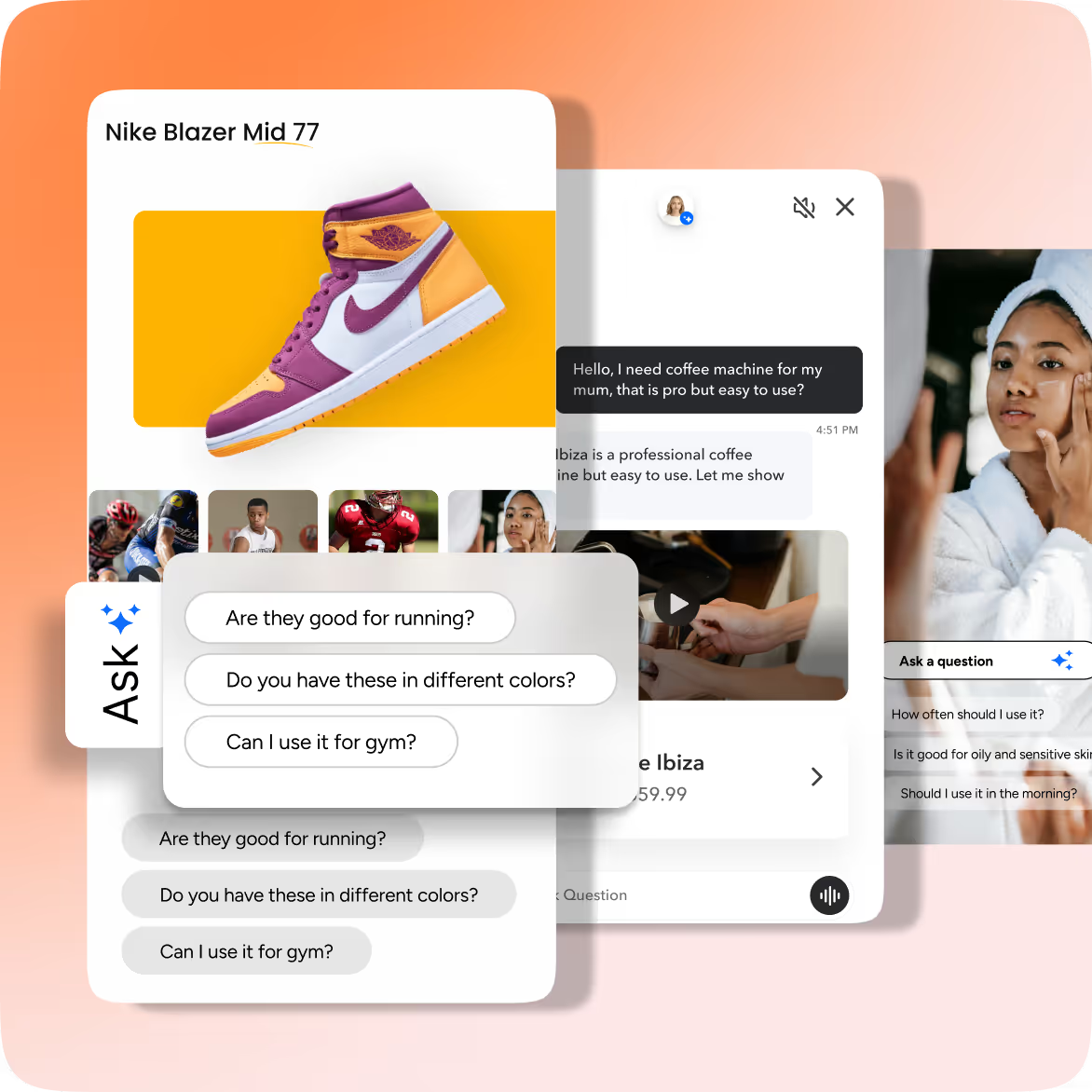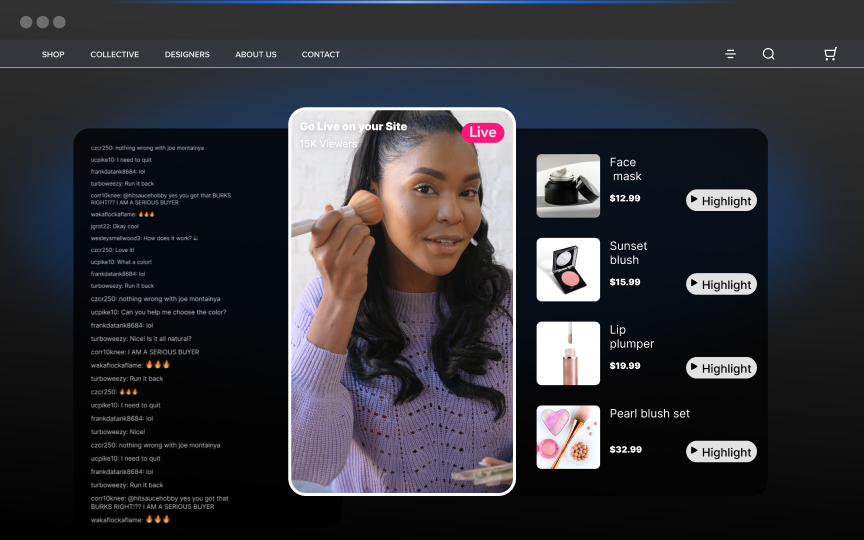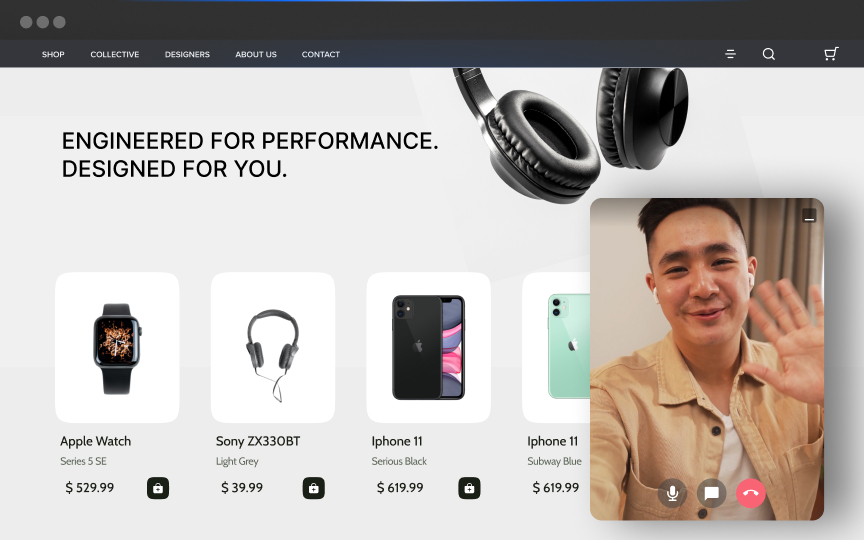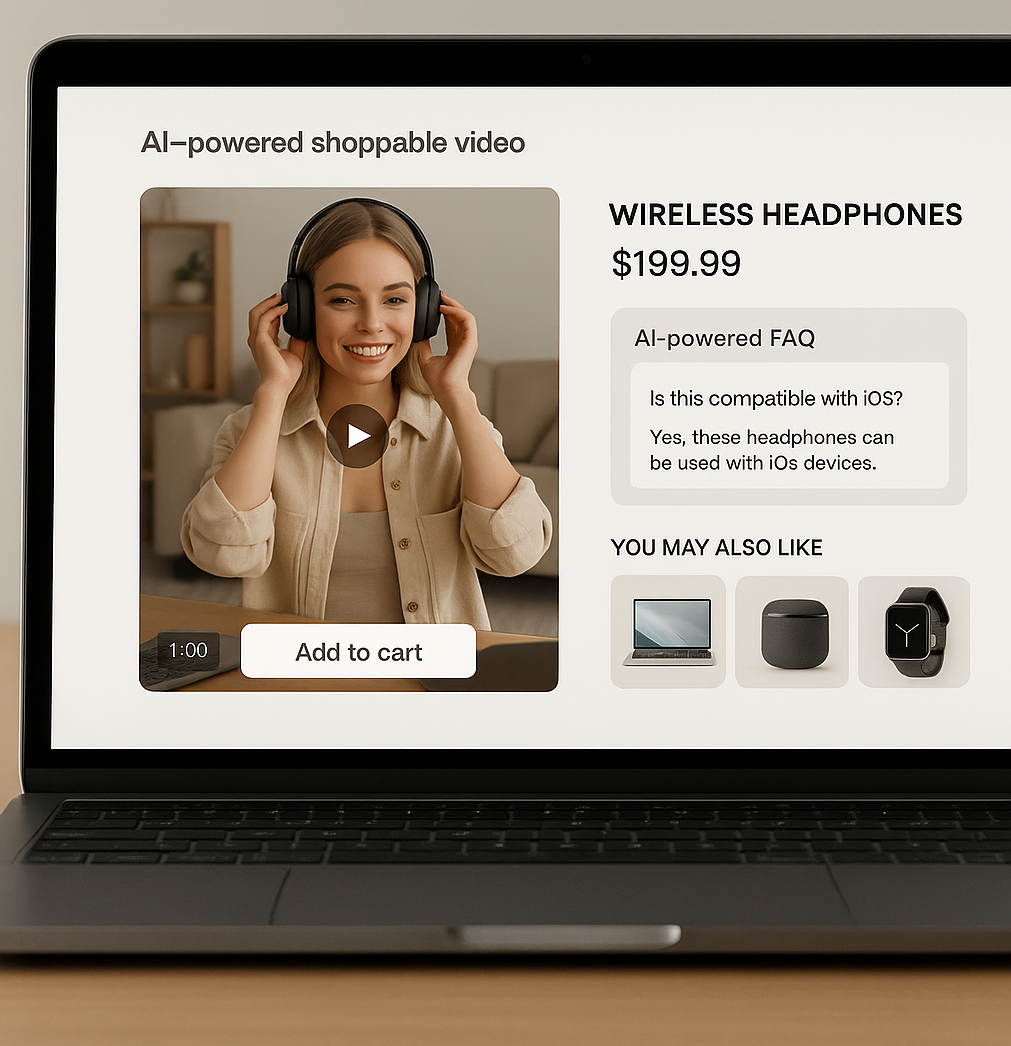Video commerce represents a significant shift in online retailing, integrating dynamic video content into shopping experiences. As businesses strive to enhance customer engagement, finding the best video commerce solutions has become essential for creating interactive, immersive shopping journeys. The evolution from static content to video-driven commerce is transforming how brands connect with customers, delivering higher conversion rates and deeper engagement.
Why Video Commerce Solutions are Becoming Essential for Businesses
Video commerce has evolved from a marketing tool into an essential strategy for online businesses. The data reveals compelling benefits that go well beyond traditional e-commerce approaches.
- Product pages with videos achieve an average conversion rate of 14.4%, compared to just 2.8% for traditional e-commerce pages without video elements
- Videos capture more attention than static content, making products more memorable while providing deeper context
- Shoppable videos streamline the buying journey by eliminating unnecessary clicks
- Direct visual demonstrations trigger stronger purchase intent, tapping into both rational and emotional decision-making factors
One major challenge in e-commerce is giving customers an accurate understanding of products. The best video commerce solutions solve this by offering transparent views of products in action, creating a "try-before-you-buy" experience that:
- Reduces cart abandonment by clarifying product features before purchase
- Lowers return rates by setting accurate expectations
- Enhances product understanding through demonstrations that static images cannot provide
With most online shopping happening on mobile devices, video commerce fits perfectly for these users. Video content engages better on smaller screens and delivers comprehensive product information in an easy-to-consume format for smartphone browsers.
Most importantly, video commerce solutions transform shopping from transactions to relationships. Livestream shopping creates community and excitement while humanizing your brand. This emotional connection sets your business apart in ways traditional e-commerce can't match.
Learn how fashion and apparel brands are leveraging video commerce in our 2025 Playbook
Key Features to Look for in Video Commerce Solutions
When evaluating video commerce platforms for your business, certain capabilities stand out as essential for driving engagement and conversions.
1. Interactive Elements
The most effective video commerce solutions transform passive viewers into active participants through:
- Clickable hotspots: Allow viewers to click directly on products within videos to learn more or purchase
- Pop-up product information: Overlays that provide additional details when users hover over or click on items
- Interactive overlays: Elements that appear at strategic moments to encourage engagement
These interactive elements can boost engagement by up to 66% compared to static media, significantly impacting purchase intent. Time triggers and strategic pauses within videos create natural opportunities for interaction without disrupting the viewing experience.
2. Shoppable Video Functionality
The core of the best video commerce solutions is making videos directly shoppable. Your solution should support:
- Live shopping capabilities: Real-time interactive events where viewers can purchase products as they're demonstrated
- Pre-recorded shoppable content: Videos with embedded product links that remain accessible indefinitely
- Multi-product tagging: The ability to showcase multiple items within a single video
Social media integration is crucial as platforms continue to develop native shopping features. The best solutions allow you to leverage your existing social media audiences while maintaining a consistent brand experience.
3. Analytics and Performance Tracking
Robust analytics are essential for measuring ROI on your video commerce investments. Look for platforms that track:
- Viewer engagement metrics: Views, watch time, drop-off points, and interaction rates
- Shopping behavior: Click-through rates on products, add-to-cart actions, and completed purchases
- Conversion attribution: Clear tracking of how videos contribute to sales
A/B testing capabilities are particularly valuable, allowing you to compare different video approaches and optimize performance over time. The most sophisticated platforms offer heatmaps showing exactly where viewers are engaging with your content.
4. AI and Personalization
Artificial intelligence is becoming a key differentiator in video commerce solutions, with features including:
- Product recommendation algorithms: AI that suggests relevant products based on viewing behavior
- Viewer behavior prediction: Tools that anticipate what content will resonate with specific audience segments
- Dynamic content adjustments: Videos that adapt based on viewer preferences or past purchases
These AI capabilities help create more personalized shopping experiences, which can significantly increase conversion rates and average order values.
5. Integration Capabilities
For seamless operation, your video commerce solution must integrate with your existing technology stack:
- E-commerce platform compatibility: Look for native integrations with major platforms like Shopify, WooCommerce, and Magento
- CRM integration: Connections to your customer relationship management system for enhanced personalization
- Content management system compatibility: Easy integration with your existing CMS workflow
Discover how leading fashion brands are using these features in our comprehensive guide
Comprehensive Analysis of Top Video Commerce Solutions
Finding the right video commerce solution for your business can be challenging. Here's a breakdown of options based on business size to help you make an informed decision.
1. Enterprise-Level Solutions
Enterprise organizations need robust, scalable video commerce platforms with advanced security and integration capabilities. These solutions offer sophisticated features tailored to large-scale operations, including:
- Advanced security protocols for protected content distribution
- Global content delivery networks ensuring consistent performance
- Robust analytics suites with conversion tracking and viewer insights
- Enterprise-grade APIs for custom integrations with existing tech stacks
Major beauty brands have seen significant sales driven directly through interactive video content. The platform's ability to scale across regions while maintaining consistent quality makes it ideal for multinational corporations.
2. Mid-Market Solutions
Mid-market businesses need solutions that balance sophistication with manageable implementation requirements. These platforms offer robust features without the complexity of enterprise systems, including:
- Intuitive interfaces with minimal learning curve
- Live streaming capabilities with interactive elements
- Customizable video players that maintain brand consistency
- Monetization options including pay-per-view and subscriptions
Mid-market retailers particularly benefit from solutions that transform standard product videos into interactive shopping experiences without requiring extensive technical resources.
3. Small Business and Startup Options
Small businesses need affordable, user-friendly solutions that deliver immediate value without requiring specialized expertise or significant resource investment. Look for:
- Mobile-first recording and editing capabilities
- Easy live streaming to social platforms
- Minimal equipment requirements for professional-looking content
- Affordable monthly pricing with flexible plans
Content creators and small businesses particularly value turnkey approaches to video monetization, allowing them to focus on content creation rather than technical implementation.
Integration Challenges and Solutions in Implementing Video Commerce
Implementing video commerce solutions comes with technical hurdles that businesses of all sizes need to navigate. Understanding these challenges and planning accordingly can save you significant time and resources.
1. Technical Compatibility Issues
One of the most common barriers businesses face is platform compatibility. Video formats and requirements vary across e-commerce platforms, making it essential to ensure your video commerce solution integrates seamlessly with your existing infrastructure.
To overcome this challenge:
- Use widely compatible file formats and codecs
- Test integration thoroughly before full deployment
- Consider solutions specifically designed for your e-commerce platform
2. Bandwidth and Performance Concerns
Videos can significantly impact page load times, potentially affecting user experience and SEO rankings. This is particularly problematic for resource-intensive platforms or regions with limited bandwidth.
Effective solutions include:
- Implementing Content Delivery Networks (CDNs) to reduce latency
- Compressing video files without sacrificing quality
- Using adaptive streaming technology that adjusts quality based on user bandwidth
3. Mobile Responsiveness
With over 60% of e-commerce traffic coming from mobile devices, ensuring your video commerce solution works flawlessly across all screen sizes is critical. Many businesses struggle with maintaining quality while adapting to smaller screens.
Best practices for mobile optimization include:
- Testing video content across multiple devices
- Employing adaptive streaming and dynamic sizing
- Creating vertical video formats for mobile-first experiences
Implementation Roadmap
- Assessment Phase (1-2 weeks)
• Audit current e-commerce platform
• Define objectives and KPIs
• Evaluate technical requirements - Solution Selection (1-3 weeks)
• Research compatible video commerce platforms
• Request demos from potential providers
• Assess integration capabilities with your e-commerce platform - Implementation (2-8 weeks, depending on business size)
• Configure platform integration
• Set up analytics tracking
• Develop initial video content - Testing (1-2 weeks)
• Verify functionality across devices
• Test load times and performance
• Ensure proper tracking of interactions - Launch and Optimization (Ongoing)
• Monitor performance metrics
• Gather user feedback
• Iterate on content and features
Learn how fashion retailers are overcoming these challenges in our detailed playbook
Measuring ROI from Implementing Video Commerce Solutions
Measuring the return on investment from your video commerce implementation requires tracking specific metrics and understanding how video impacts your overall business performance.
Setting Clear Objectives and KPIs
Before implementing video commerce, establish SMART (Specific, Measurable, Achievable, Relevant, Time-bound) KPIs to properly measure success. These might include:
- Conversion rate increases from video-enabled product pages
- Average order value changes when videos are present
- Engagement metrics like watch time and drop-off points
- Reduction in product return rates
Without these predefined objectives, you'll struggle to determine whether your investment is delivering results.
Key Performance Indicators to Track
Different metrics reveal different aspects of your video commerce success:
- Engagement metrics: Track video views, watch time, and drop-off points to understand customer interest
- Conversion metrics: Monitor click-through rates from videos, add-to-cart actions, and actual purchases
- Customer experience metrics: Measure changes in customer satisfaction, return rates, and repeat purchases
- Technical performance: Assess page load times and mobile responsiveness to ensure videos aren't hampering the user experience
The most successful implementations use detailed analytics tools that integrate with existing e-commerce platforms to track these KPIs effectively.
Realistic Timeline for Returns
Video commerce implementations typically show results according to this timeline:
- Short-term (1-3 months): Expect to see improvements in engagement metrics and some early conversion lifts
- Medium-term (3-6 months): Look for more substantial conversion rate increases and measurable impact on average order values
- Long-term (6+ months): Evaluate overall sales growth, return rate reductions, and customer lifetime value improvements
Be patient—while some businesses see immediate results, the full impact of implementing video commerce solutions typically develops over time as you optimize your approach and build a library of effective content.
Future Trends in Video Commerce
The video commerce landscape is evolving rapidly with several technological advancements set to reshape how brands engage with consumers. These innovations will create more immersive and personalized shopping experiences.
Augmented reality (AR) and virtual reality (VR) integration are becoming central to the best video commerce solutions. These technologies allow customers to visualize products in their own spaces before purchase, dramatically reducing purchase hesitation. For furniture retailers and fashion brands, this means customers can see how items look in their homes or on themselves.
AI-driven personalization is another significant advancement. Recommendation engines now analyze viewer behavior to suggest products tailored to individual preferences. These AI systems are becoming increasingly sophisticated, moving beyond basic demographic targeting to understand nuanced shopping patterns.
Mobile optimization continues to be critical as more e-commerce traffic shifts to smartphones. Brands are developing video commerce experiences specifically designed for mobile interfaces, with vertical formats and touch-focused interactions becoming standard practice.
Multi-device compatibility is also gaining importance. The most effective video commerce platforms now ensure seamless experiences across smartphones, tablets, desktops, and even smart TVs, allowing consumers to begin shopping journeys on one device and complete them on another.
Sustainability and accessibility are emerging as key priorities in the video commerce space. Brands are increasingly focusing on how their digital experiences can be more inclusive for all users, including those with disabilities, while also considering the environmental impact of their digital strategies.
See how forward-thinking fashion and apparel brands are preparing for these trends
Ready to Transform Your E-commerce Strategy with Video Commerce?
The shift to video commerce isn't just a trend—it's the future of online retail. With conversion rates jumping from 2.8% to over 14% when video is implemented effectively, the business case is clear.
Now is the time to evaluate how video commerce can elevate your customer experience and drive meaningful business results. Whether you're a fashion retailer looking to showcase your latest collection or a beauty brand wanting to demonstrate products in action, video commerce creates the engaging, interactive experiences today's consumers demand.
Take the next step in your video commerce journey:
Download our 2025 Fashion & Apparel Video Commerce Playbook to discover how leading brands are revolutionizing their digital shopping experiences through interactive video solutions.
Don't just sell products—create memorable shopping experiences that build lasting customer relationships and drive sustainable growth through the power of video commerce.
Unlock Exclusive Insights
By submitting this form, you agree to Firework's privacy policy and consent to receive personalized marketing communications. You can unsubscribe at any time.




























.png)